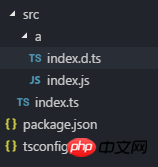
This time I will bring you the connection between Js and TypeScript, and what are the precautions for using Js and TypeScript. The following is a practical case, let’s take a look.
Preface
TypeScript is a superset of JavaScript types. This is a sentence introduced in the TypeScript documentation. So are they related?
My understanding is that TypeScript introduces the characteristics of a strongly typed language based on JavaScript. Developers use TypeScript syntax for programming development, and finally convert TypeScript into JavaScript through conversion tools.
Using TypeScript can avoid the pitfalls of weakly typed languages caused by developing on native JavaScript. (What should I enter? What should I return after the call? Let’s take a look at the source code...)
Hmm! Very good, strongly typed JavaScript, very good. However, I can’t bear the meticulous humanistic care of many libraries in NPM o(TヘTo)
Don’t be afraid, many libraries now quietly support TypeScript. Even if they have no intention of supporting it, there are still big guys who make selfless contributions. Quietly help these libraries support TypeScript
This leads to the topic of this article, the TypeScript declaration file. I think it is a header file for the JavaScript library similar to the C language. Its existence is to help TypeScript introduce the JavaScript library.
What is a declaration file?
is very similar to C/C *.h header files: when you reference a third-party library (.lib/.dll/ .so/.a/.la), the C/C compiler cannot automatically recognize the exported names and function type signatures in the library, which requires the use of header files for interface declarations.
Similarly, the TypeScript declaration file is a TypeScript code file with the .d.ts suffix, but its role is to describe the type information of all exported interfaces within a JavaScript module (in a broad sense).
For the writing and specifications of TypeScript declaration files, please refer to the following official documents and excellent blog posts:
First initialize the TypeScript project, the directory structure is as follows:
tsconfig The .json configuration is as follows: 
{
"compilerOptions": {
"target": "es5",
/* Specify ECMAScript target version: 'ES3' (default), 'ES5', 'ES2015', 'ES2016', 'ES2017', or 'ESNEXT'. */
"module": "commonjs",
/* Specify module code generation: 'none', commonjs', 'amd', 'system', 'umd', 'es2015', or 'ESNext'. */
"allowJs": true,
"outDir": "./dist",
/* Redirect output structure to the directory. */
/* Allow javascript files to be compiled. */
"strict": true /* Enable all strict type-checking options. */
},
"include": [
"src/**/*"
]
}const NAME = 'A';
let call = (who) => {
console.log('Hello ' + who + '! I am ' + NAME);
}
export default {
call
}declare namespace a {
function call(who: string): void;
}
export default a;import a from './a';
a.call('Pwcong');Execute the command node ./dist/index.js to get the corresponding correct output. 
The content of node_modules/b/types/package.json is as follows: 
{
"name": "b",
"version": "1.0.0",
"main": "./src/index.js",
"types": "./types/index.d.ts"
}const NAME = 'B';
let call = (who) => {
console.log('Hello ' + who + '! I am ' + NAME);
}
module.exports = {
call
}声明文件 node_modules/b/types/index.d.ts 内容如下:
declare namespace b {
function call(who: string): void;
}
export = b;这时,我们修改 src/index.ts :
import a from './a';
a.call('Pwcong');
import b = require('b');
b.call('Pwcong');相信看了本文案例你已经掌握了方法,更多精彩请关注php中文网其它相关文章!
推荐阅读:
The above is the detailed content of Js connects with TypeScript. For more information, please follow other related articles on the PHP Chinese website!




